Tuesday Triage #79
- TUESDAY TRIAGE #79 by Vadim Drobinin
- On sausage making
- Things I enjoyed reading
- 1. How to be useless by @Helenreflects
- 2. The power of defaults by @lehrjulian
- 3. How bad is my gas stove? (Part Two) by @carbonswitch
- 4. I Think I Know Why You Can't Hire Engineers Right Now by Nash Reilly
- 5. Cognitive Load Theory and its Applications for Learning by @scotthyoung
- 6. How do you visualize code? by @lxmkls
- 7. ID systems analysed: e-Estonia (X-Road) by @privacyint
- 8. Effortless personal productivity (or how I learned to love my monkey mind) by @jakobgreenfeld
- 9. Learn the workings of Git, not just the commands by Andre Fachat
- 10. Getting Started with Lockpicking by @yaelwrites
- Things I didn't know last Tuesday
- 1. Brown Windsor soup
- 2. Curse of the Colonel
- 3. Platinum Pudding Competition
- 4. Venywhere
- 5. Rat tickling
- 6. PERQ window manager
- 7. Canned Green Pepper
- 8. Chetvergova ("Maundy Thursday's") salt
- 9. Cartes de visite
- 10. Queen Fredegund
- Book of the week
- Thank you and see you in a week!
TUESDAY TRIAGE #79
by Vadim Drobinin ¶
Your weekly crème de la crème of the Internet is here!
18.01.2022 (read in browser)
-
Intro
Whatever is on my mind this week. -
Things I enjoyed reading
Ten-ish articles I found worth reading. -
Things I didn't know last Tuesday
Ten-ish facts I didn't know when I wrote the previous edition. -
Book of the week
Some thoughts on the latest book I've read.
On sausage making ¶
My default method of cooking meat boils down (he-he) to vacuum-packing it and dropping into sous vide.
This might be a bit excessive for small pieces (like a steak), but works wonders for huge piece like a pork shoulder or a brisket, which is then finished in the oven. Adding curing salts ensures the smoking ring, and a few drops of liquid smoke make it feel real.
This time I thought I am ready for trying out the classic recipe though, and trimmed down a 4 kg piece for my trials:
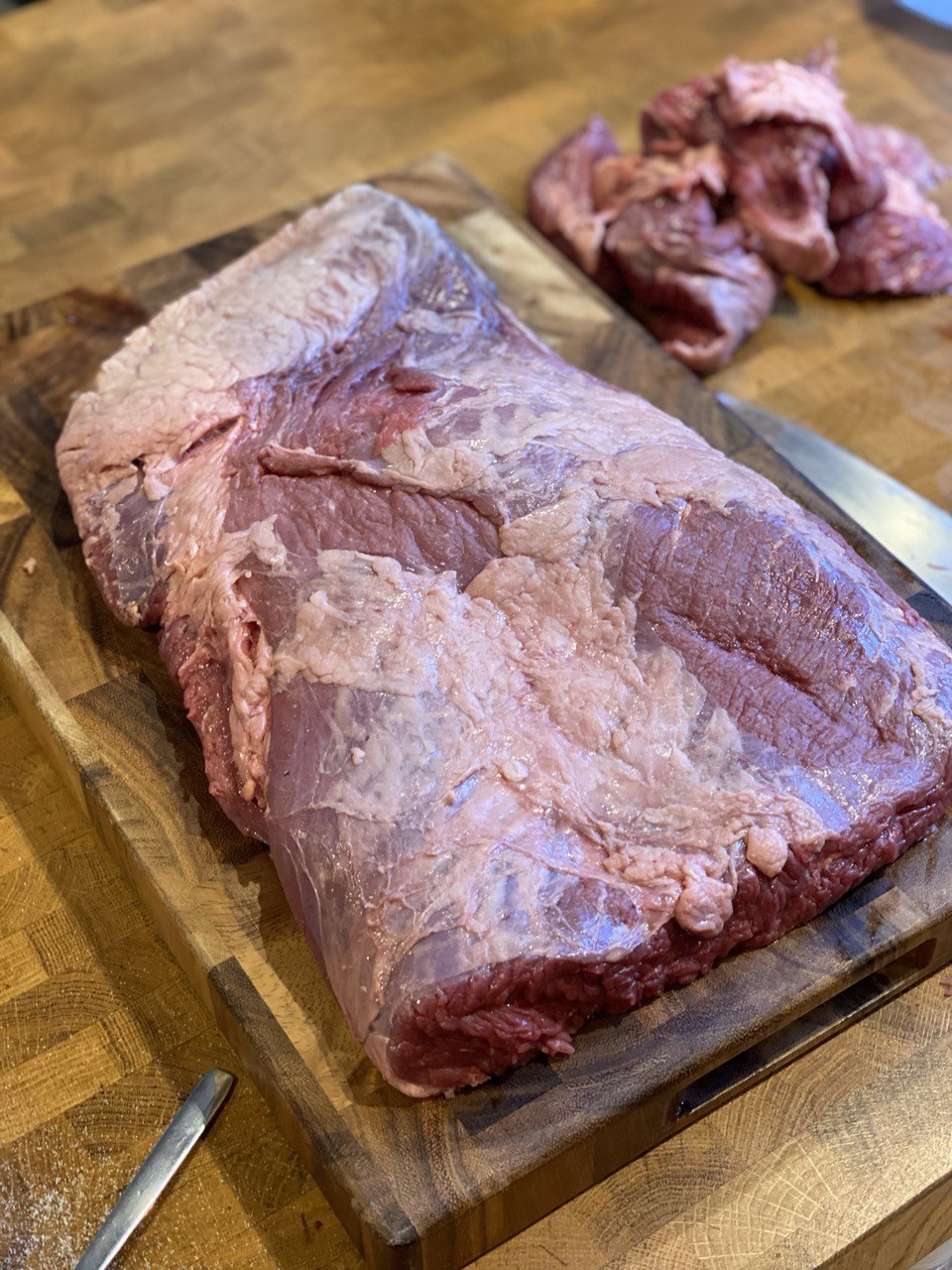
While it was warming up in a 50/50 rub I also tried to burn leeks, and now I am pretty ashamed I didn't try them that way before:
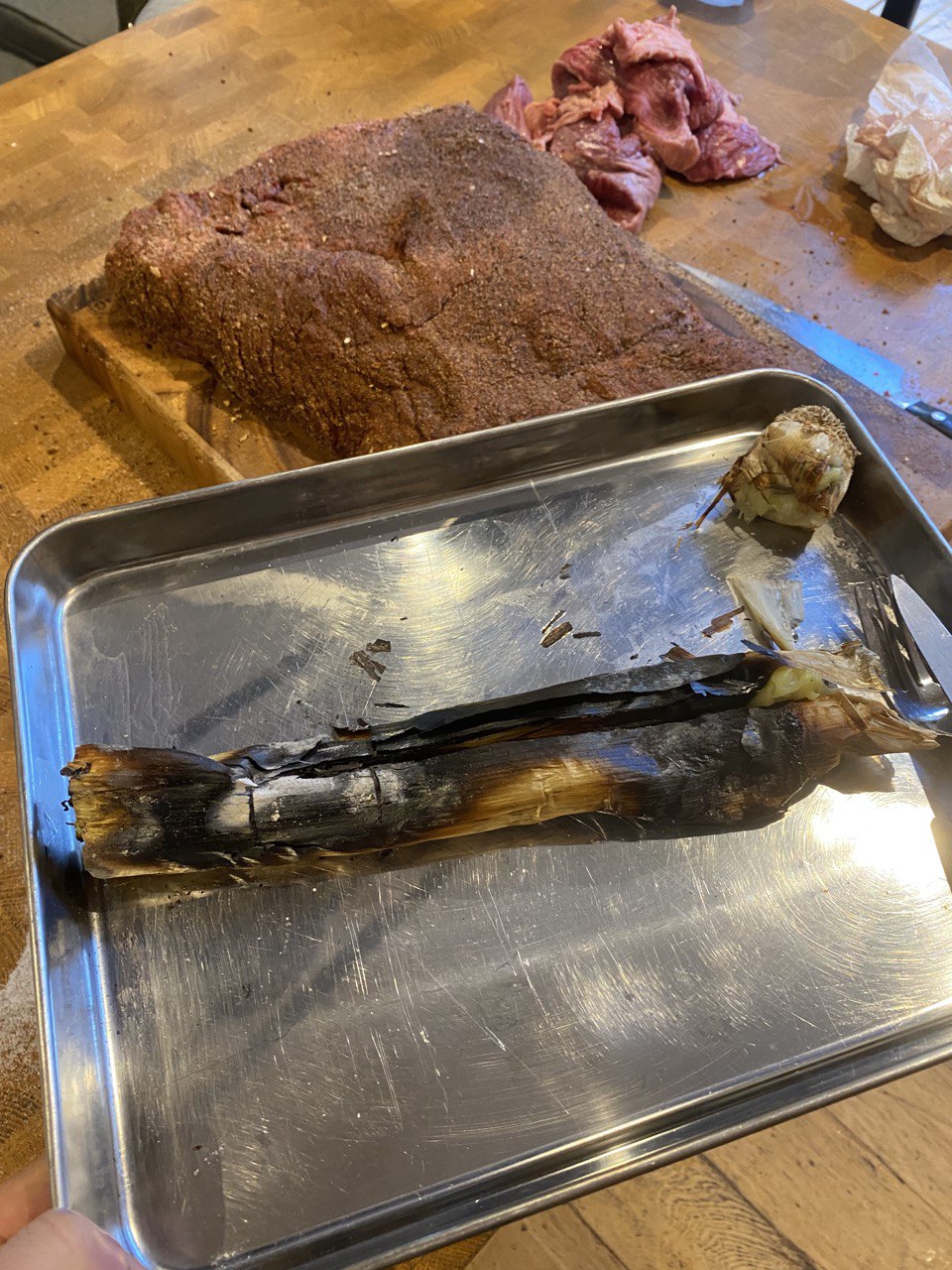
8 hours in the smoker and then a few more wrapped up in the oven (once it's wrapped up, smoke doesn't really stick to the bark, so there is no point in wasting coal):

And after resting for a few hours:
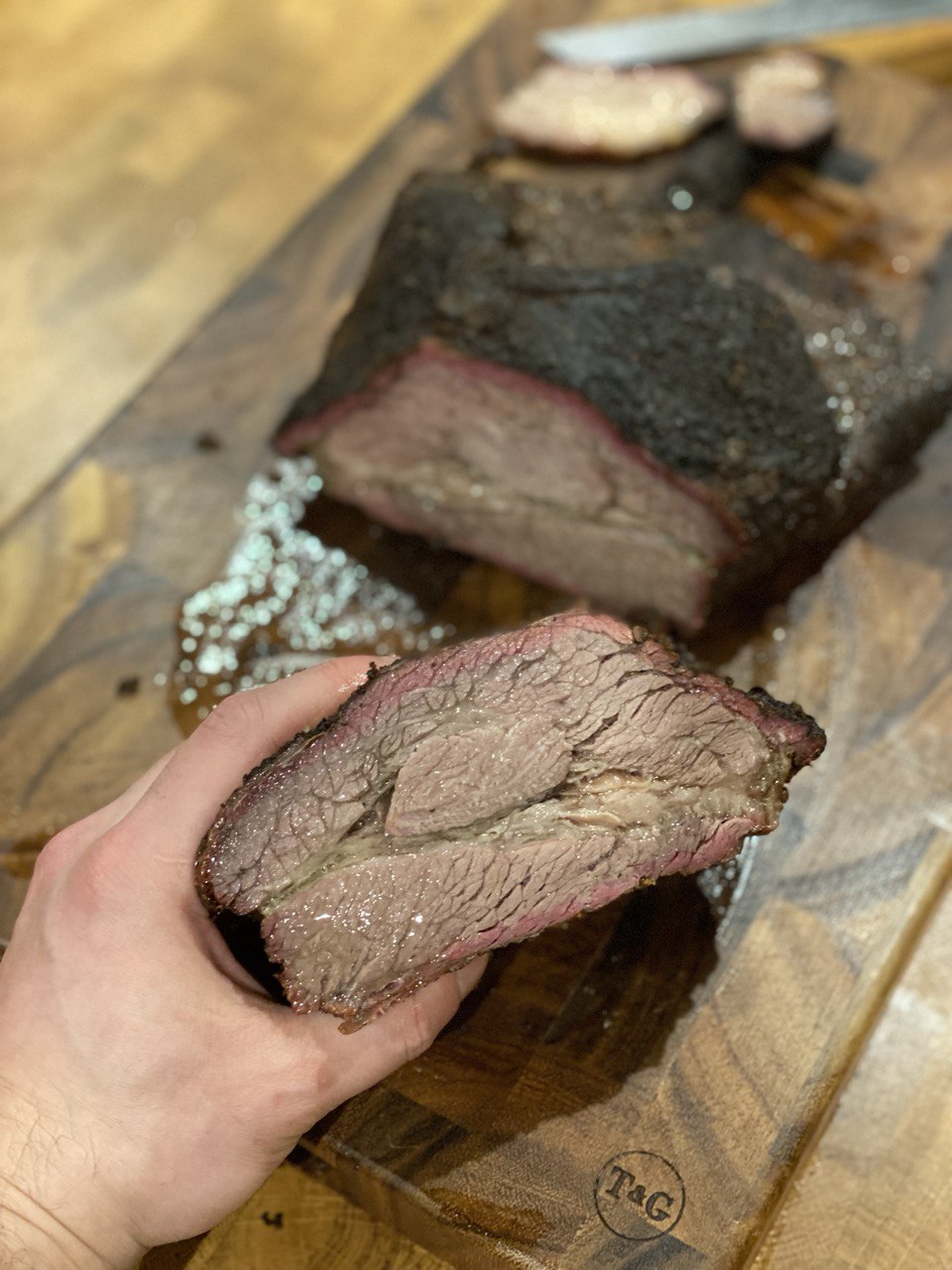
Personally I am not yet fully happy with the results: while it has way more flavour to it than the sous vide version, cooking it was way more effort and the meat wasn't as tender and falling apart as after two days in vacuum. I probably should try cooking more, that's it.
There was also almost a kilogramm of trimmings, and their fat ratio looked perfect for some sausages. The problem with most English sausages is that they're mostly pork-based, but I found a quick recipe for Old Oxford sausages, which calls for soaked rusk and spices.
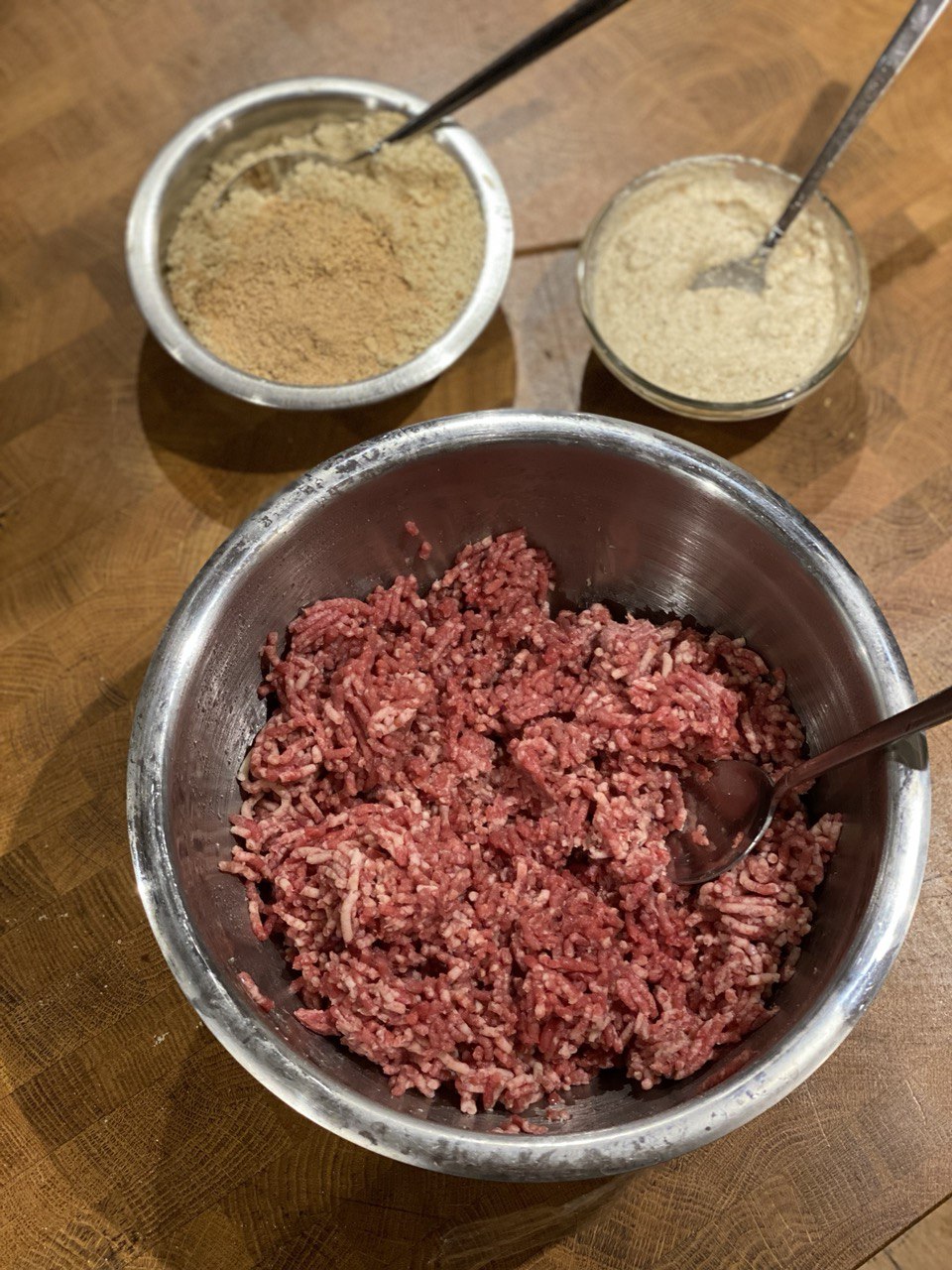
This time the process was way smoother than when I was making fermented saucisson sec.

I still have to improve my linking game though:

After resting overnight in the fridge we gave them a try:

And honestly I am pleasantly surprised with my very first batch: lots of flavour, the brisket shines through, and the texture is very recognisable as of a classic English sausage.

Classic recipes also add a red colouring to the mix, but I thought it won't really change much. Probably next time worth adding anyway.
Things I enjoyed reading ¶
1. How to be useless by @Helenreflects ¶
Those familiar with Daoism might as well know about Zhuangzi, an ancient text with stories and anecdotes, teaching how to stop caring about stuff:
Within the Zhuangzi, we can identify another reason for why we should not strive to be useful: trying to be useful can end up being harmful to yourself. The gnarly tree can remain standing because it is deemed useless, whereas the tree that is neat and straight is cut down for timber. Zhuangzi later tells the story of a dream in which a similarly deformed oak tree says of its more useable brethren: ‘Their utility makes life miserable for them, and so they don’t get to finish out the years Heaven gave them, but are cut off in mid-journey.’ Sometimes uselessness is survival, or even enables one to thrive.
I read its translation years ago, so don't really know how close it was to the actual text, and yet do believe that once you stop striving to impress or serve a purpose your life gets only better.
2. The power of defaults by @lehrjulian ¶
A great essay on the importance of defaults (whether it's values, products, or apps):
The beautiful thing about defaults is that they beat almost any competing product – even if that competitor has strong network effects or is technically superior.
This is why Apple Maps has higher market share than Google Maps, why Apple Music is able to catch up with Spotify, and why Google pays Apple $15bn a year to remain the default search engine on Safari.
While I personally find Apple Music better than Spotify (and Google Maps better than Apple Maps), I can't really argue that without being a default option many products would never stay at the market for so long (looking at you, Bing).
3. How bad is my gas stove? (Part Two) by @carbonswitch ¶
For quite some time I was sad that when changing flats we had to move onto an electric stovetop. As someone who cooks a lot I do appreciate the instant response gas stoves have, and their compatibility with pretty much any pan materials.
There are cons as well though:
There was one day of the week that NO2 levels didn’t spike, however. Every Tuesday we get takeout and, unsurprisingly, on those nights, NO2 levels were much lower.
The holidays offered another opportunity for testing. On Christmas Eve, we went to the mountains to visit my family for a night. When I looked at the air quality monitor data for that day, I saw that our NO2 levels were lower than any other day in the month.
I am linking to the second part as that's where the most details are, but do have a look at the first part as well.
4. I Think I Know Why You Can't Hire Engineers Right Now by Nash Reilly ¶
If you participate in hiring engineers these days, you probably know how hard it is.
And if you are an engineer, chances are your mailbox is full of unexpectedly generous offers for companies you've never heard about.
Any game theorists in the audience have correctly deduced by now that the Best Alternative To Negotiated Agreement here is: the status quo. Is an extra $10k per year worth learning a new org, a new skillset, a new set of expectations, a new set of coworkers, and a new boss?
For many engineers, the answer is: “No.”
As someone who happens to play for both sides of the equation at the moment, I am indeed surprised that companies are not ready yet to fix their interview pipelines and benefits for the state the world is in.
Coffee and cookies in the office don't really work anymore, while a budget for a home office might as well be a great perk to have, as well as a four-day work week.
5. Cognitive Load Theory and its Applications for Learning by @scotthyoung ¶
I probably heard about this theory at some point in the past, but have not seen yet such a simple explanation of its main ideas:
One reason problem solving is difficult is that it requires you to keep in mind the goal you’re trying to reach, how far you are from the goal, and potential operations to move forward. This creates a lot of cognitive load that makes it harder to identify the solution procedure.
Removing an explicit goal can also reduce cognitive load. For example, a classic trigonometry problem might ask a student to find a particular angle. A “goal-free” way to present this would be to ask students to find as many angles as possible.
I'd love to read more about applying them to learning languages (if that's even possible), as the article just touches on it.
6. How do you visualize code? by @lxmkls ¶
Some good food for thought:
This made me think about how I tend to visualize code, and it’s a little hard to describe. I think it usually lives in my head in a variety of ways, depending on the level of abstraction and specificity, and there’s some combination of all of them there at the same time. Depending on the need, I can jump between them pretty well, especially if I’m very familiar with the codebase.
The author shares a few examples as well, and at least some of them definitely remind me of the ways I tend to imagine code myself. And it's hard to describe indeed.
7. ID systems analysed: e-Estonia (X-Road) by @privacyint ¶
I used to have Estonian e-citizenship. It got deprecated at some point (as I got lazy and stopped renewing it), but it was a beautiful piece of technology: a mixture of 2FA and a passport, that held the power to open bank accounts and create companies without borders.
Everything comes at a price though:
More worrying, and not limited to 120,000 faulty cards affected, is a core design feature regarding the way private encryption keys were generated and handled. The ID card's private encryption key used to authenticate digital signatures should be generated inside the card chip to ensure only that card knows it - a good example of privacy by design. Instead, keys were generated in a server operated by the card manufacturer and copied to the card over the internet.
That being said, technologies will always be broken or affected by malicious players, but it shouldn't decrease the value of them: just prompt better mediation strategies.
8. Effortless personal productivity (or how I learned to love my monkey mind) by @jakobgreenfeld ¶
Something I can definitely relate to: productivity happens when you start to accept yourself with all your flaws, and once you acknowledge those it gets way easier to work around them:
In distraction mode, my mind is looking for new inputs. It usually occurs when I’m not 100% convinced that what I’m doing is what I really should be doing.
My way of embracing it is to always have a (virtual) box of healthy intellectual “snacks” ready.
This is important because otherwise, it’s easy to just doomscroll for hours and consume intellectual junk.
So instead of fighting with the urge to eat cakes before bed make them healthy and keep eating.
9. Learn the workings of Git, not just the commands by Andre Fachat ¶
These days the knowledge of Git is pretty much expected for any developer, and yet by "knowledge" we usually mean "capability to execute five commands in any order until one of them works".
On one hand, it's pretty sad, but on the other unless you work in a very big company with lots of people working on the same chunks of code, you don't really need much.
And yet it's great to learn the internals too, and this is a very easy-to-read intro:
In Git, however, there is no such thing as a master branch. Wait, didn’t I write above that there commonly is a master branch? Yes, I did. However. This master branch only exists locally. There is no relationship between the master branch in one repository and the one in another repository, except for the relationship you create.
I can't say I got more efficient at my Git-fu straight away, but definitely got a better understanding of some parts.
10. Getting Started with Lockpicking by @yaelwrites ¶
I don't think I've mentioned it before, but at some point Sasha gifted me a lockpicking set, and I had to pick a lock in order to get to the last gift. I didn't really got any better than that, but now as well might get back to it, as this is a very detailed guide on what to do next:
When you have some locks, if things are just a bit too tough, you can either remove some pins in the locks to make things easier or go back online and buy a set that gets progressively more difficult: ones with just two pins, all the way up to five or even six pins. If you're planning on removing pins yourself you'll need tweezers and some place to store them--corrugated cardboard is the least expensive if you want to d.i.y. it, but pinning mats are inexpensive, too.
Also I can confirm that it's lots of fun and makes watching heist movies slightly more hilarious from now on.
Things I didn't know last Tuesday ¶
1. Brown Windsor soup ¶
For quite a while there was a belief that Queen Victoria had a favourite soup:
Brown Windsor soup’s fame extends far beyond the hijinks of The Goon Show. Cookbooks including The Daily Mail Modern British Cookbook typically describe the “thick meat soup” as a popular dish in Victorian times, with some recipe authors going so far as to call it “Queen Victoria’s favorite.” The dish is so synonymous with traditional Victorian-era gastronomy that recipes for it appear in The Unofficial Harry Potter Cookbook and The Unofficial Downton Abbey Cookbook. Characters dine on brown Windsor soup in a 1994 episode of Agatha Christie’s Poirot, just as they do in the 2021 television adaptation of Around the World in 80 Days.

Apparently that's a myth, and the soup was invented way later (and probably somewhat inspired by ads of a soap with the same name).
2. Curse of the Colonel ¶
The dark side of KFC you probably didn't know about: a baseball team in Japan for years thought they're cursed by the ghost of Colonel Sanders, because they dumped his statue in the water.
The Colonel was finally discovered in the Dōtonbori River on March 10, 2009. Divers who recovered the statue at first thought it was only a large barrel, and shortly after a human corpse, but Hanshin fans on the scene were quick to identify it as the upper body of the long-lost Colonel. The right hand and lower body were found the next day, but the statue is still missing its glasses and left hand. It is said that the only way the curse can be lifted is by returning his long-lost glasses and left hand.
Wonder if someone who finds the lost glasses would get their own statue? Dropping it into water might as well start a new loop.
3. Platinum Pudding Competition ¶
I was reading through some conspiracy theories about Her Majesty the Queen being dead (which is obviously not true, but those conspiracy fans suggest that it won't be announced until her 69th year as a monarch finishes to prevent possible jokes), and stumbled across (a very real) announcement:
As part of this summer’s Platinum Jubilee celebrations, the royals have partnered with Fortnum and Mason and former Great British Bake Off judge Mary Berry on a “platinum pudding” competition. Designed to emulate the coronation chicken created for Elizabeth’s ascendance to the throne in 1953, the pudding should, according to the competition rules, comply with the following criteria [...]
The criteria are not really specific, so as far as the result is "fit for the Queen" you might have chances of winning (but only if you are not a professional cook).
There are still a few weeks left to send them the recipe, just saying.
4. Venywhere ¶
Venice, Italy is desperate to attract even more people and came up with a fun way to lure young professionals in:
Unlike remote-worker programs in less-charismatic sites, Venywhere isn’t offering cash incentives to prospective residents. Instead, digital nomads who want to move to Venice will pay a one-time fee to get access to a concierge service that eases them into Venetian life: viewing apartments on their behalf, advising them on how to get a SIM card or access the health system, and even showing them where to shop.
I've never been to Venice but would imagine it gets quite busy in the summer, so probably not the best placefor digital nomads. I am not one though, so can't really tell anyway.
5. Rat tickling ¶
When someone says to you that keeping laboratory rats is cruel, show them how much effort is put into their well-being:
Tickling is increasingly recognised as an effective means of improving laboratory rat welfare through mimicking natural play habits.
Must be a very popular skill among scientists then.
6. PERQ window manager ¶
It was hard to pick a single fact from a very detailed article on the history of graphical user interfaces, but I have never heard of PERQ before and it actually looks pretty cool for something fourty years old:
The PERQ window manager partitioned the screen into overlapping, user dimensionable windows and supported menus and light buttons. The “process mechanism” used the window manager to allow direct user control of multiple concurrent processes. Applications developed for PERQ included graph plotting software, a graphical spreadsheet package,charting software, games etc.
Given that in so many years interfaces didn't change much, I am really excited for what is there to come. Virtual reality? Neural links? Bring it on!
7. Canned Green Pepper ¶
Yeah, it's an odd one: I didn't even think of canning green pepper (not like sweet pepper, but like pepper the spice), and yet people add it to food:
The separated green pepper berries are washed and filled in cans containing a diluted solution of sodium chloride with or without added acidity. The filled cans are then sealed and sterilized by the autoclave process, and cooled under running water. Europe, USA and Australia use canned green pepper for flavouring food and garnishing meat dishes.

8. Chetvergova ("Maundy Thursday's") salt ¶
There is this type of salt in Russia, which originally was a part of orthodox rituals, but these days made its way into restaurants and hipster cafes.
I couldn't find English sources, so please put up with my translation of Russian Wikipedia:
Coarse moist salt was mixed with kvass mash or soaked rye bread, tied in a rag or put in an old birch-bark bast shoe, and then burn for 3-4 hours in a Russian oven or buried in ashes. Next step was to pound it in a mortar, all while reading prayers (both during calcination and pounding). Then the salt was consecrated in the altar.
It looks quite... burnt, but tastes rather nice (for some reason the flavour is very similar to that of a boiled egg):

9. Cartes de visite ¶
Some insights into flirting before Tinder was invented (so circa 1860s):
Around 1860, Britain was gripped with a craze for cartes de visite – small photographic visiting cards, featuring staged portraits of the owner. It became de rigueur to swap cards, with even only vague acquaintances eagerly collecting each other's image for their scrapbooks. Making photocollages in dedicated albums – by cutting up those calling cards and repurposing them within watercolour painted backdrops, to often silly, surreal or even suggestive effect – became quite the fashionable activity for members of the British aristocracy. Admiring each other's albums in drawing rooms was a popular after-dinner pastime.
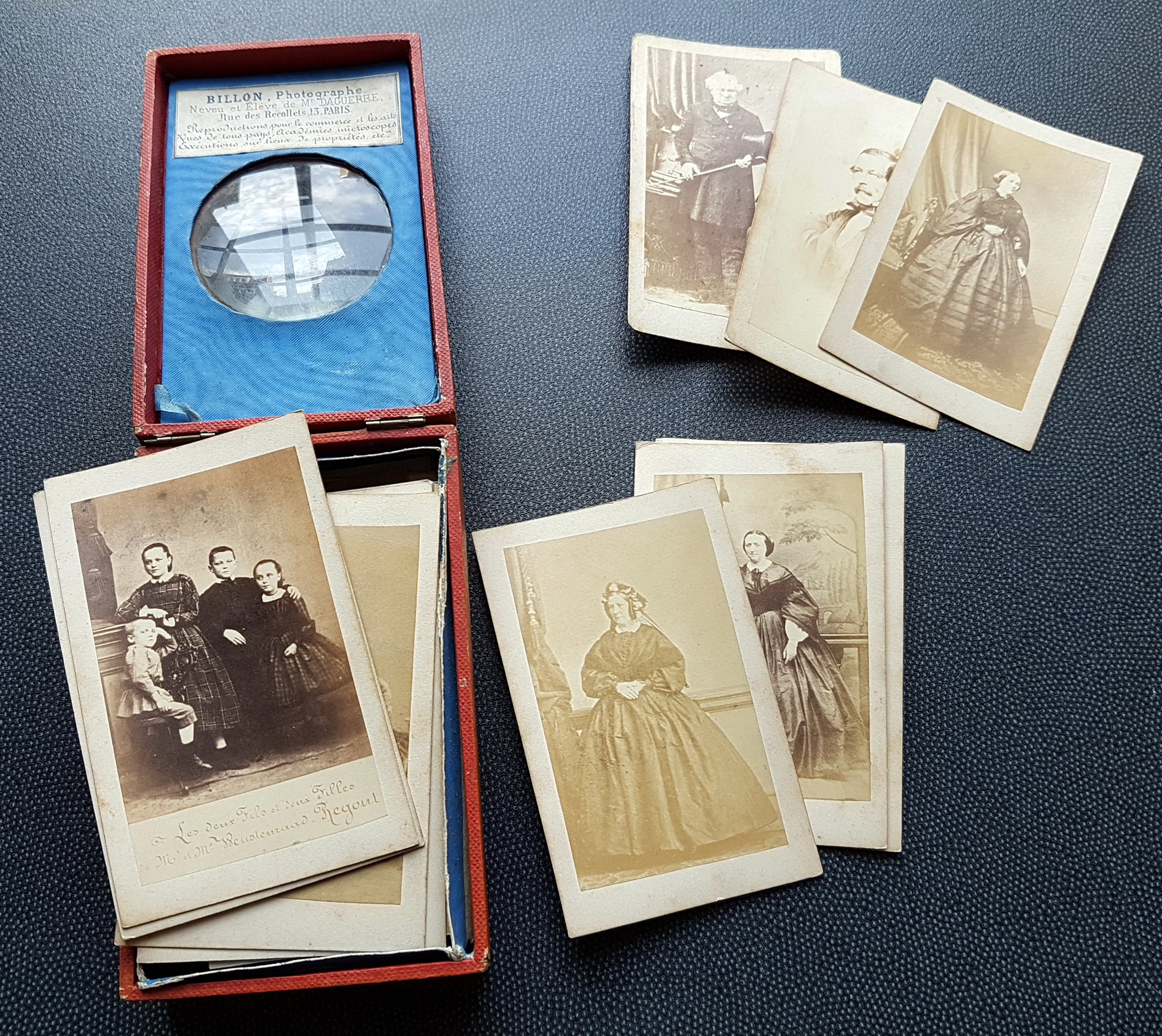
10. Queen Fredegund ¶
From a very interesting story about medieval queens who were quickly forgotten:
Fredegund handed the boys a small glass vial—of poison. While there were many poisons in the Merovingian arsenal, there were only two that could kill on contact: wolfsbane and snake venom. But both lost potency fairly quickly and needed to be applied to the weapon right before an attack. If the account from Gregory of Tours is to be believed, Fredegund had access to both the medical texts of antiquity and the ability to compound dangerous herbs or extract snake venom.
It already looks like more fun than 90% of historical series I've watched.
Book of the week ¶
As you might have guessed from the intro, this week I was very devoted to briskets (whether ground or smoked), and the reason behind it is Aaron Franklin's book Franklin Barbecue.
I have heard of Aaron multiple times, and usually in the context of "there is this truck in Texas where people queue for brisket for hours" or "there is this BBQ chef who does only one thing but very well".
And while this is indeed true, I never suspected the man in question to be also a very humble person happy to share all secrets of their trade:
Toward the end of that night, Big Jeff, my great friend who’s been a part of my barbecue journey since close to the beginning, came up and said, “Hey, I got this for you,” and handed me a manila envelope. In it was a roll of ones, fives, and maybe some tens.
“What’s this?”
“I took donations for you tonight,” he said, taking a slug of whiskey. “You need it.”
I didn’t know he’d been asking people for money, and I got a little choked up because it was the most thoughtful thing. Throwing that cook probably cost us the equivalent of our rent. The money he raised might not have completely covered our expenses, but it helped a lot. I just couldn’t believe it, because I’d worked so hard and had so much fun and then at the end of the night I got paid, which I never expected.
The book is more of a dairy, where the author shares with us his thoughts, dreams, and meat cooking wisdom, and the actual recipes take up 10% of the book at best.
However, and that was news for me, barbeque doesn't really work well with recipes: every meat cut is different, and both smoker and the weather could change a lot.
Some time ago I complained about baking being too precise, while I value the flexibility of cooking without measuring out gramms.
Well, apparently smoking meat is the ultimate antipode of baking, and so far I am quite behind at it (if only by my standards).
Thank you and see you in a week! ¶
If you have any questions, or want to suggest a link for the next newsletter, please drop me a message on Twitter or reply to this email.
Cheers! 🍸